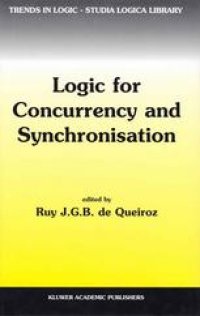
Ebook: Logic for Concurrency and Synchronisation
Author: Ruy J. G. B. de Queiroz (ed.)
- Genre: Mathematics // Logic
- Tags: Logic, Theory of Computation, Mathematical Logic and Foundations
- Series: Trends in Logic 15
- Year: 2003
- Publisher: Springer Netherlands
- Edition: 1
- Language: English
- pdf
The study of information-based actions and processes has been a vibrant - terface between logic and computer science for several decades now. Indeed, several natural perspectives come together here. On the one hand, logical s- tems may be used to describe the dynamics of arbitrary computational p- cesses – as in the many sophisticated process logics available today. But also, key logical notions such as model checking or proof search are themselves informational processes involving agents with goals. The interplay between these descriptive and dynamic aspects shows even in our ordinary language. A word like “proof” hdenotes both a static ‘certificate’ of truth, and an activity which humans or machines engage in. Increasing our understanding of l- ics of this sort tells us something about computer science, and about cognitive actions in general. The individual chapters of this book show the state of the art in current - vestigations of process calculi such as linear logic, and – with mainly two major paradigms at work, namely, linear logic and modal logic. These techniques are applied to the title themes of concurrency and synchronisation, but there are also many repercussions for topics such as the geometry of proofs, categorial semantics, and logics of graphs. Viewed - gether, the chapters also offer exciting glimpses of future integration, as the reader moves back and forth through the book.
The study of information-based actions and processes has been a vibrant interface between logic and computer science for decades now. The individual chapters of this book show the state of the art in current investigations of process calculi with mainly two major paradigms at work: linear logic and modal logic. Viewed together, the chapters also offer exciting glimpses of future integration with obvious links including modal logics for proof graphs, labelled deduction merging modal and linear logic, Chu spaces linking proof theory and model theory and bisimulation-style equivalences for analysing proof processes.
The combination of approaches and pointers for further integration also suggests a grander vision for the field. In classical computation theory, Church's Thesis provided a unifying and driving force. Likewise, modern process theory would benefit immensely from a synthesis bringing together paradigms like modal logic, process algebra, and linear logic.
If this Grand Synthesis is ever going to happen, books like this are needed!
The study of information-based actions and processes has been a vibrant interface between logic and computer science for decades now. The individual chapters of this book show the state of the art in current investigations of process calculi with mainly two major paradigms at work: linear logic and modal logic. Viewed together, the chapters also offer exciting glimpses of future integration with obvious links including modal logics for proof graphs, labelled deduction merging modal and linear logic, Chu spaces linking proof theory and model theory and bisimulation-style equivalences for analysing proof processes.
The combination of approaches and pointers for further integration also suggests a grander vision for the field. In classical computation theory, Church's Thesis provided a unifying and driving force. Likewise, modern process theory would benefit immensely from a synthesis bringing together paradigms like modal logic, process algebra, and linear logic.
If this Grand Synthesis is ever going to happen, books like this are needed!
Content:
Front Matter....Pages i-xxi
Geometry of Deduction Via Graphs of Proofs....Pages 3-88
Chu’s Construction: A Proof-Theoretic Approach....Pages 89-109
Two Paradigms of Logical Computation in Affine Logic?....Pages 111-144
Proof Systems for ?-Calculus Logics....Pages 145-212
A Tutorial Introduction to Symbolic Model Checking....Pages 215-237
Modal Logics for Finite Graphs....Pages 239-267
Bisimulation and Language Equivalence....Pages 269-284
Back Matter....Pages 285-285
The study of information-based actions and processes has been a vibrant interface between logic and computer science for decades now. The individual chapters of this book show the state of the art in current investigations of process calculi with mainly two major paradigms at work: linear logic and modal logic. Viewed together, the chapters also offer exciting glimpses of future integration with obvious links including modal logics for proof graphs, labelled deduction merging modal and linear logic, Chu spaces linking proof theory and model theory and bisimulation-style equivalences for analysing proof processes.
The combination of approaches and pointers for further integration also suggests a grander vision for the field. In classical computation theory, Church's Thesis provided a unifying and driving force. Likewise, modern process theory would benefit immensely from a synthesis bringing together paradigms like modal logic, process algebra, and linear logic.
If this Grand Synthesis is ever going to happen, books like this are needed!
Content:
Front Matter....Pages i-xxi
Geometry of Deduction Via Graphs of Proofs....Pages 3-88
Chu’s Construction: A Proof-Theoretic Approach....Pages 89-109
Two Paradigms of Logical Computation in Affine Logic?....Pages 111-144
Proof Systems for ?-Calculus Logics....Pages 145-212
A Tutorial Introduction to Symbolic Model Checking....Pages 215-237
Modal Logics for Finite Graphs....Pages 239-267
Bisimulation and Language Equivalence....Pages 269-284
Back Matter....Pages 285-285
....